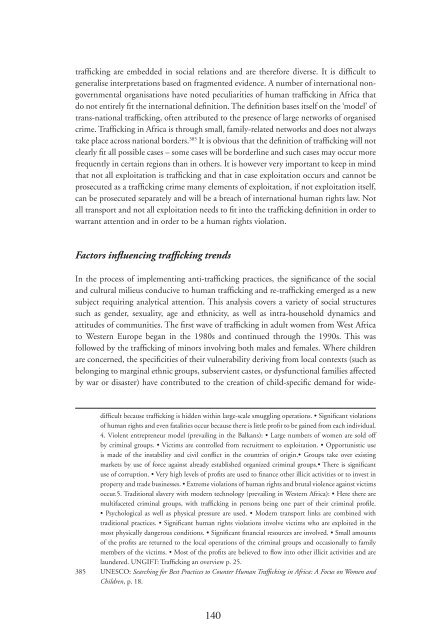Trafficking in human beings: human rights and ... - unesdoc - Unesco
Trafficking in human beings: human rights and ... - unesdoc - Unesco
Trafficking in human beings: human rights and ... - unesdoc - Unesco
Create successful ePaper yourself
Turn your PDF publications into a flip-book with our unique Google optimized e-Paper software.
traffi ck<strong>in</strong>g are embedded <strong>in</strong> social relations <strong>and</strong> are therefore diverse. It is diffi cult to<br />
generalise <strong>in</strong>terpretations based on fragmented evidence. A number of <strong>in</strong>ternational nongovernmental<br />
organisations have noted peculiarities of <strong>human</strong> traffi ck<strong>in</strong>g <strong>in</strong> Africa that<br />
do not entirely fi t the <strong>in</strong>ternational defi nition. The defi nition bases itself on the ‘model’ of<br />
trans-national traffi ck<strong>in</strong>g, often attributed to the presence of large networks of organised<br />
crime. Traffi ck<strong>in</strong>g <strong>in</strong> Africa is through small, family-related networks <strong>and</strong> does not always<br />
take place across national borders. 385 It is obvious that the defi nition of traffi ck<strong>in</strong>g will not<br />
clearly fi t all possible cases – some cases will be borderl<strong>in</strong>e <strong>and</strong> such cases may occur more<br />
frequently <strong>in</strong> certa<strong>in</strong> regions than <strong>in</strong> others. It is however very important to keep <strong>in</strong> m<strong>in</strong>d<br />
that not all exploitation is traffi ck<strong>in</strong>g <strong>and</strong> that <strong>in</strong> case exploitation occurs <strong>and</strong> cannot be<br />
prosecuted as a traffi ck<strong>in</strong>g crime many elements of exploitation, if not exploitation itself,<br />
can be prosecuted separately <strong>and</strong> will be a breach of <strong>in</strong>ternational <strong>human</strong> <strong>rights</strong> law. Not<br />
all transport <strong>and</strong> not all exploitation needs to fi t <strong>in</strong>to the traffi ck<strong>in</strong>g defi nition <strong>in</strong> order to<br />
warrant attention <strong>and</strong> <strong>in</strong> order to be a <strong>human</strong> <strong>rights</strong> violation.<br />
Factors <strong>in</strong>fl uenc<strong>in</strong>g traffi ck<strong>in</strong>g trends<br />
In the process of implement<strong>in</strong>g anti-traffi ck<strong>in</strong>g practices, the signifi cance of the social<br />
<strong>and</strong> cultural milieus conducive to <strong>human</strong> traffi ck<strong>in</strong>g <strong>and</strong> re-traffi ck<strong>in</strong>g emerged as a new<br />
subject requir<strong>in</strong>g analytical attention. This analysis covers a variety of social structures<br />
such as gender, sexuality, age <strong>and</strong> ethnicity, as well as <strong>in</strong>tra-household dynamics <strong>and</strong><br />
attitudes of communities. The fi rst wave of traffi ck<strong>in</strong>g <strong>in</strong> adult women from West Africa<br />
to Western Europe began <strong>in</strong> the 1980s <strong>and</strong> cont<strong>in</strong>ued through the 1990s. This was<br />
followed by the traffi ck<strong>in</strong>g of m<strong>in</strong>ors <strong>in</strong>volv<strong>in</strong>g both males <strong>and</strong> females. Where children<br />
are concerned, the specifi cities of their vulnerability deriv<strong>in</strong>g from local contexts (such as<br />
belong<strong>in</strong>g to marg<strong>in</strong>al ethnic groups, subservient castes, or dysfunctional families affected<br />
by war or disaster) have contributed to the creation of child-specifi c dem<strong>and</strong> for wide-<br />
diffi cult because traffi ck<strong>in</strong>g is hidden with<strong>in</strong> large-scale smuggl<strong>in</strong>g operations. Signifi cant violations<br />
of <strong>human</strong> <strong>rights</strong> <strong>and</strong> even fatalities occur because there is little profi t to be ga<strong>in</strong>ed from each <strong>in</strong>dividual.<br />
4. Violent entrepreneur model (prevail<strong>in</strong>g <strong>in</strong> the Balkans): Large numbers of women are sold off<br />
by crim<strong>in</strong>al groups. Victims are controlled from recruitment to exploitation. Opportunistic use<br />
is made of the <strong>in</strong>stability <strong>and</strong> civil confl ict <strong>in</strong> the countries of orig<strong>in</strong>. Groups take over exist<strong>in</strong>g<br />
markets by use of force aga<strong>in</strong>st already established organized crim<strong>in</strong>al groups. There is signifi cant<br />
use of corruption. Very high levels of profi ts are used to fi nance other illicit activities or to <strong>in</strong>vest <strong>in</strong><br />
property <strong>and</strong> trade bus<strong>in</strong>esses. Extreme violations of <strong>human</strong> <strong>rights</strong> <strong>and</strong> brutal violence aga<strong>in</strong>st victims<br />
occur.5. Traditional slavery with modern technology (prevail<strong>in</strong>g <strong>in</strong> Western Africa): Here there are<br />
multifaceted crim<strong>in</strong>al groups, with traffi ck<strong>in</strong>g <strong>in</strong> persons be<strong>in</strong>g one part of their crim<strong>in</strong>al profi le.<br />
Psychological as well as physical pressure are used. Modern transport l<strong>in</strong>ks are comb<strong>in</strong>ed with<br />
traditional practices. Signifi cant <strong>human</strong> <strong>rights</strong> violations <strong>in</strong>volve victims who are exploited <strong>in</strong> the<br />
most physically dangerous conditions. Signifi cant fi nancial resources are <strong>in</strong>volved. Small amounts<br />
of the profi ts are returned to the local operations of the crim<strong>in</strong>al groups <strong>and</strong> occasionally to family<br />
members of the victims. Most of the profi ts are believed to fl ow <strong>in</strong>to other illicit activities <strong>and</strong> are<br />
laundered. UNGIFT: Traffi ck<strong>in</strong>g an overview p. 25.<br />
385 UNESCO: Search<strong>in</strong>g for Best Practices to Counter Human Traffi ck<strong>in</strong>g <strong>in</strong> Africa: A Focus on Women <strong>and</strong><br />
Children, p. 18.<br />
140

















